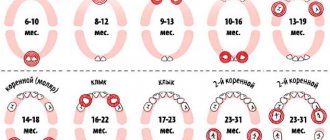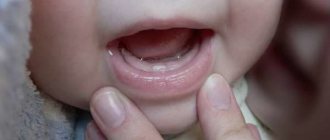The process of eruption of eye teeth causes concern for both parents and the child, as they provoke the emergence of a number of problems. For kids it’s a painful and unpleasant sensation, for their parents it’s worry about the child’s condition. This is not an easy process, since teething may cause symptoms of other diseases, in particular conjunctivitis.
In this article
- What are eye teeth?
- Signs of eruption of eye teeth
- How to alleviate a child's condition
Signs of eruption of eye teeth
The main signs of teething include:
- lacrimation, often developing into conjunctivitis;
- swelling and redness of the gums, when touched the child begins to cry;
- runny nose (if it is not transparent, but green or yellow, then there is an infection in the child’s body);
- an increase in temperature (if it exceeds 38 degrees, you should urgently consult a doctor, as this may be a signal that more serious diseases are beginning to develop);
- itching in the gums, due to which the baby tries to put everything that is at hand in his mouth.
Moreover, against the background of eruption of eye teeth, not only conjunctivitis can occur, but also a number of other specific diseases, often infectious, since immunity is reduced. You can make sure that these diseases are associated with teething only after consulting a doctor and receiving test results.
Introduction
The eruption of primary teeth in children is a natural and physiological process. However, in some cases it may be accompanied by numerous unpleasant symptoms, such as fever, loss of appetite, child anxiety, sleep disturbances and indigestion.
Anatomical and physiological features of the maxillofacial region of children
Considering the anatomical and physiological features of the maxillofacial region of children in the process of teething, it should be noted that the nature of the changes will depend on the age of the child. A newborn has no teeth in the oral cavity.
During this period, the mucous membrane covering the edge of the alveolar process forms a dense cushion over it. The oral mucosa in newborns has a similar structure in all parts. Subsequently, differences appear in the structure of various parts of the oral mucosa.
The gums of infants also differ in structure from the gums of adults: the connective tissue is more delicate, there is less elastic tissue, and a greater number of cellular elements. At the end of the child's first year of life, there is a noticeable increase in elastic tissue in the gums. In the soft tissues surrounding the tooth before eruption, slight hyperemia is noted [1].
Mechanism of teething
The eruption of a tooth is one of the links in the chain of processes of its development, which begins in the prenatal (in utero) period and continues for several years after eruption. This process is associated with the growth and development of the child’s entire body.
Teeth are considered erupted when they reach the occlusal surface, i.e. contact with the teeth of the opposite jaw. In this case, part of the enamel in the cervical area remains under the gum.
The mechanism of eruption is quite complex. By the time the tooth erupts, atrophy and resorption of the area of bone covering the crown of the tooth occurs. Similar processes occur in the gums. When a tooth erupts, simultaneously with the resorption of bone tissue in some areas, its formation occurs in others. During root growth, processes of bone restructuring also take place, and a gradual deepening of the dental alveoli occurs.
During teething, morphological changes occur in the teeth and surrounding tissues. There is an increase in blood supply, a change in vascular permeability, an increase in the production of the basic substance of the pulp and periodontium, and atrophic changes in the gums over developing teeth occur [2].
Physiological teething
Physiological teething is characterized by three main features: certain timing, pairing and sequence of eruption [3]. Temporary teeth begin to erupt in a child at an average of 6–7 months. The generally accepted timing of teething, presented by Kronfeld (see table) [4].
However, when analyzing the literature data, it can be stated that the timing of tooth formation, eruption, formation and resorption of roots is individual for each child, therefore different authors indicate different timing in their studies.
In addition, the data vary depending on the region of residence of the child: for example, in the northern regions of Russia there is a more frequent deviation from the average timing of teething towards later teething [6].
The eruption of primary teeth is influenced by many factors, and sometimes even a combination of them. Studies have shown that the eruption of primary teeth in young children is most strongly influenced by the mother’s chronic diseases, the presence of bad habits, diseases during pregnancy, gestosis and diseases of the child in the first year of life [5].
Pathology of eruption of primary teeth
The pathology of the eruption of primary teeth can include early, late and difficult eruption. Violation of the pairing and sequence of eruption of primary teeth also refers to the pathology of eruption.
Earlier eruption of baby teeth may adversely affect the resistance of their tissues to the action of negative factors. When teething in a child at the age of 3 months after birth, due to imperfect structure and insufficient mineralization of hard tissues, lack of hygienic care, earlier damage to temporary teeth by caries is possible.
Particular attention should be paid to pre-erupted primary teeth. Most often these are the lower central incisors, very rarely - the upper ones. The structure of teeth that erupted in utero is defective; their roots have not yet finished forming. Such temporary teeth can lead to complications for both the mother and the child. When sucking, the teeth injure the mother's nipple, which often causes mastitis. Such teeth should be removed soon after eruption. There is currently no generally accepted explanation for the reasons for such premature eruption [7].
A significant delay in the onset of teething may indicate a violation of the child’s physical development, some kind of metabolic disorder or a general somatic disease.
Violation of the timing, pairing and sequence of eruption of primary teeth can serve as a marker of various diseases, for example, rickets, endocrine disorders, hypothyroidism. Research has shown that the eruption of primary teeth in the group of children with rickets begins on average 3.5 months later when compared with healthy children; a violation of the sequence of eruption of temporary teeth is observed in 52.31% of children with rickets; a violation of paired eruption is observed in 35 .38% [5].
Teething in children with different constitutional types has its own distinctive characteristics. For example, in infants with a lymphatic-hypoplastic type of constitution, which is characterized by lymphadenopathy, excess body weight, delayed static-motor development, more often than in children with other types of constitution, late eruption of primary teeth, severe anxiety, crying, and disturbances are observed. character of the stool, more pronounced swelling and soreness of the gums, profuse salivation. In children with a neuro-arthritic type of constitution, which is based on an increase in the synthesis of uric acid, accompanied by manifestations of sympathicotonia, teething is timely, but occurs with severe pain in the gum area, high fever, the smell of acetone from the mouth, increased regurgitation up to fountain vomiting, increased excitability. In infants with exudative-catarrhal (allergic) type of constitution, teething also occurs within the prescribed time frame, but is more often accompanied by the addition of a respiratory viral infection and exacerbation of atopic dermatitis [8].
The eruption of primary teeth is a natural physiological process that usually does not cause any significant changes in the health of children. However, a number of children develop a symptom complex that, according to the International Classification of Diseases (ICD), is classified as teething syndrome (ICD code - K00.7).
Often, respiratory viral, intestinal infections, dysbiosis, and urinary tract infections can be hidden under the guise of teething. Thus, teething syndrome is more of a diagnosis of exclusion and is made only after other pathological conditions have been excluded.
Symptoms of difficult teething in a child are divided into two groups: general and local. General symptoms - anxiety, moodiness, decreased appetite or even refusal to eat, excessive salivation, low-grade fever - are non-specific and may indicate not only teething, but also another disease. The appearance of cough against the background of teething is caused by hypersalivation and saliva entering the upper respiratory tract. Loose stools are also associated with increased salivation and increased bowel movements. Local symptoms - swelling and redness of the gums at the site of the future tooth, pain on palpation of the eruption site - accurately indicate teething [9, 10].
The most common undesirable manifestations of teething include increased salivation, swelling and soreness of the gums, behavioral disturbances in the child, an increase in body temperature to subfebrile levels with the possible addition of rhinitis, and decreased appetite [11].
Therapy methods
Today, there are pharmacological and non-pharmacological methods of therapy for the eruption of primary teeth [12].
To reduce the severity of pathological symptoms of teething in infants, various medications are used. They can be of general and local action.
In cases of severe pain and fever, non-steroidal anti-inflammatory drugs (NSAIDs) are used, which reduce body temperature and have a systemic analgesic effect.
In order to relieve the main symptoms of teething - agitation, anxiety, increased temperature due to teething, as well as relieving pain and swelling of the mucous membrane, the drug Dantinorm-Baby is used, which includes chamomile (reduces irritability, temperature), laccone (used for pain and inflammation of the gums) and rhubarb (digestion is stabilized).
Dantinorm-Baby has an innovative dosage form - the only sterile solution for oral administration in individual dosage containers.
Dantinorm-Baby is produced in France using the most modern blow-fill-seal technology (“Blow-Fill-Seal” - BFS). It is a single process in which a single machine forms a container and aseptically fills it with a single dose of sterile solution in a very short time. Speed and extremely high safety standards are two advantages of this process: sealed, ready-to-use monodoses of the drug in just 12 seconds. Each dose of Dantinorm-Baby is ideal for children, as it ensures sterility, dosing accuracy and hygiene for non-contact use. Unlike dental gels, the duration of action of 1 dose of this drug is ~ 8 hours. Thus, just 3 doses per day of the dosed solution provide continuous protection against teething symptoms 24 hours a day [13].
The drug contains only natural ingredients, so it can be used in children from birth.
To relieve local symptoms of the eruption of primary teeth in children, various gels are used. Any teething gel usually has a local effect and cannot provide long-term pain relief. It is recommended to use such gels no more than 5–6 times a day to avoid the development of side effects, incl. allergic. The main goal when prescribing a gel for teething is to reduce the intensity of pain and prevent the inflammatory process on the gum mucosa.
Gels with an anesthetic effect containing lidocaine or benzocaine increase the risk of allergic reactions. Studies have shown that the gels contact the gums for a short time, then the child swallows it. This time is not enough for pain relief, however, with frequent use, the child swallows too much gel, which can lead to seizures, severe brain damage, and heart problems. Gels containing choline salicylate exhibit effects associated with aspirin and may cause Reye's syndrome in susceptible children [14].
Non-pharmacological methods of treating symptoms of eruption of primary teeth include a simple and accessible method - massage of the gingival ridges. When pressing on them, the pain syndrome decreases. For massage you can use special silicone brushes. Cool gel or silicone teethers reduce swelling, also reducing pain.
Conclusion
Thus, teething in many children is accompanied by a number of nonspecific syndromes and is a diagnosis excluding other pathological conditions. It is necessary to familiarize parents with this problem and introduce the safest, preferably natural, drugs that help alleviate the pain of this condition in children.









